you could use a 600 - 600 audio isolation transformer along with a 3 prong plug with the chassis grounded. This will increase the current safety level as the chassis is grounded. all changes are made while power is disconnected. A 50 watt isolation transformer is a good idea.
I found this M3 at a Goodwill store for $39.95. I was told that due to it's age it was not tested and the plug was cut off to prevent anyone from plugging it in. It was being sold as "furniture." Upon getting it home I discovered that the cord was still intact, just stuffed up inside, so you know what I did......It works perfectly too. Made in 1957 it still has all it's original tubes and capacitors.
Nice find. God has pretty much screwed me, as far as finding those kinda deals go
I've read articles on Fender Champs and other amplifiers, where some techs say leave em alone, because sometimes the old caps actually make the amp sound "better" to some players. Do What?! I've also read horror stories where an amp was brought in for repair, the tech decided to do a full recap, and the player said that they've DESTROYED their sound!
I'm guessing that the old caps added a bit of distortion that they grew accustom to or something. I thought about this a bit more, and I came to this conclusion: Why not just make the amp perfectly linear and in perfect working order, and if you want to distort the waveform, do it with a preamp or a pedal. As I've stated before, I am an audio neophyte/noob, but to my way of thinking, this sounds logical, or am I missing something here?
The M3 is known as the "baby B3" but it isn't exactly a lightweight at 250 pounds. It's what Booker T (Green Onions and many more) learned his chops on.
Booker is another player that I give high praise and respect, for sure!
I remember seeing an M3 offered for cheap somewhere in this forum. Try searching here!
I'd love to pick one up on the cheap, but I'm not sure I could afford the shipping
The Mellotron was actually the first "sampling keyboard" using a strip of magnetic tape for each key. It could sound like whatever was recorded on the tapes.
I think it was the Moody Blues keys player that said it took forever and a day to set one up with samples, and it also broke down constantly. Still, I'd love to see one in one of music museums. I'd also love to inspect the interior of one of those things and check out the schematic. Yet another search
73,
Randy AB5NI
Short answer: don´t.Hey Gang,
Recently, I was thinking about adding the aforementioned things in the title to am old AM radio. I recapped the line caps (AA5 Radio) and removed the hum, and I'll eventually recap old caps that need replacement for proper bias and so forth, accordingly. (Will run em through ESR and so on.)
1) AA5 is a live chassis device, which will KILL you 50% of the times you plug it in an outlet and plug a guitar into it to be amplifier.
Yes, I read about your Powerite.
Since it´s an expensive heavy Bench/Lab device, I doubt you´ll carry it everywhere to power that cheesy AA5 radio, so I can NOT assume "you can leave the Safety problems aside" ... at all.
You need a dedicated $15 isolation transformer, but from some of the answers I assume you won´t be buying one, so .....
Oh, you went to "You Tube University"Looking around on YouTube
Short answer: wrong assumptions., I've noticed A LOT of videos that say to just jump on in on the volume control -- fine with low-voltage DC, but not with high-voltage-DC circuits we get with tubes --
Wrong.and a lot of folks out there are doing so and NOT taking the high voltage on the grid input seriously and as an electrical-shock hazard!
No "high voltage on the grid"
That is, a lot of these videos -- most, if not all, mind you -- are going straight-line to the grid.
No. Read above.Some do use coupling caps to feed the audio, but as most of us are aware, if that cap shorts closed, they'll have 250-300 VDC right on the input jack(s).
Maybe because there is no high voltage on the grid?The seriously sad thing here is that I'm seeing this garbage on factory-built, guitar amplifiers. Other than that cap, there is no physical isolation being used.
To connect a Guitar (High Z) to a grid input? (again High Z)I was told in another forum that I could use an old 600-600 transformer out of an old transistor AM radio to solve the issue,
NO
No.but I'm not really sure of the exact setup to do such a thing. I would guess that I could take two stereo leads from the line-level output of my computer and connect each lead to each input lead on the primary, ground one side of the secondary, and head the other lead over to the volume control? I guess I could even add a variable RC network for a bit of tone control at that point as well.
Yes.I got to thinking about all of this a bit more, and I'm wondering if the 600-600 transformer is going to be the correct input impedance for the tube, and my brain tells me, "No! This has to be calculated for the correct impedance for maximum-power transfer!"
WHICH radio transformer?Can I get away with just using the AM-radio transformer?
Non relevant.If not, I have a TON of Amidon cores hanging around, so winding my own transformer shouldn't be that big of a deal, I'm guessing. I know Amidon has some info out there on how to best use their cores, so I'm sure that could help.
Only safe use would be the bluetooth receiver, which I guess is remote controlled.I guess I can do some switching on the input jacks, which would allow 3.5mm, RCA phono, and 1/4" inputs to be selected as well, and I should be able to purchase a stereo Bluetooth receiver on the cheap on Amazon or E-Bay. Any suggestions?
Cool, that´s what we are trying to do .BTW, I'm a software engineer, and I am self-taught in electronics, but I think I might get the gist of the situation if you could explain where I could be going wrong, or a helpful point in the right direction might work just as well.
RF amplifiers and transmitters work with DEADLY voltages but:You are talking about a transformer for the AC line. Well, I didn't plan on adding one.
I have been playing around with very-high voltage for many years, building numerous 3KV 3-500z and 3 and 4-1000 amplifiers for RF work.
a) they sit inside closed and grounded metal cases, no way you can touch dangerous voltages, at all.
b) they are transformer powered, not straight from mains.
Tubelab wrote:
One of my customers did exactly that: muting Bass strings with left hand while catching Tango Singer´s SM58 with the right one.People have been killed by gripping a hot guitar in one hand and grabbing a grounded mic with the other.
He´s alive only because at the time he was less than 30 y.o. and had a strong young heart. And even so ......
And he could not let go, somebody kicked the microphone away.
Irrelevant.I've already changed the across-the-line cap with a proper safety cap, btw. Actually, that's the very first thing I do when working on a AA5.
If you mean a 2 prong cord, that is UNSAFE.I've also installed a proper cord as well, which is polarized correctly
There is NO guarantee the wall jack is properly wired.
If you mean a 3 prong cord, you can NOT do that UNLESS you added an isolation transformer.
It´s not a PRR issue but a SAFETY issue.this house was built in the 60's and wired with 12-2 with no ground,.... I'm left with is neutral and hot. Man, PRR is really gonna be disgusted with me when he reads that! A apologize beforehand, PRR!
In fact continuing the discussion the way it´s going is against Forum rules.
Forget insurance for a minute, we are talking your LIFE here.Unfortunately, I no longer have the health to run proper wiring across my home to my ham shack. Even if I could do the work myself, there are clauses in insurance contracts that state something along these lines: "If you wire it yourself and it causes your home to burn down, we ain't paying you crap!"
Then stop fiddling with UNSAFE equipment , that is even cheaper.So, what that means is that I have to hire a certified electrician to do the work and have it inspected, and that's not cheap
Short answer, NO.Wait. I think I might have a saving grace. About 20 years ago or so, I had an electrician install a 220 line for my amplifier(s). It was a new run, so I take it that he wired the thing properly for code. Why couldn't I just rewire that run for 110? Would that suffice and make you guys happy?
And again, it isn´t a "happyness" situation but abiding by official Safety rules.
You chosen the WORST possible example of Single Ended Class A amplification possible.As far as using an AA5 for audio amplification goes, I was thinking along the lines of this: It would be a cheap way of hearing semi-decent, single-ended class A audio amplification.
Ok, this is going nowhere.
Finished my coffee break, back to useful things.
Howdy Stock,
Thanks for the input, my friend. I've ordered 5 of them that work in-line with the power cord. Actually, I plan on repairing and making a few more of these setups to give as xmas gifts for the younger kids in my family.
The idea here is to set things up so that the kids can use something like this in a dorm room or something in a close-space environment and hear decent quality, tube audio. Most of them have only heard compressed MP3's on cheap laptop speakers or their cell phones, and when they actually hear quality tube audio, even on an AA5, they are completely blown away.
I have a friend that built a couple of 300B mono-blocks that are connected to a pair of B&W speakers, and when they hear their favorite tunes on that setup, they are like "OMG! OMG! OMG! I had NO idea that my music could sound like that!"
73,
Randy AB5NI
you could use a 600 - 600 audio isolation transformer along with a 3 prong plug with the chassis grounded. This will increase the current safety level as the chassis is grounded. all changes are made while power is disconnected. A 50 watt isolation transformer is a good idea.
Thanks for the input, my friend. I've ordered 5 of them that work in-line with the power cord. Actually, I plan on repairing and making a few more of these setups to give as xmas gifts for the younger kids in my family.
The idea here is to set things up so that the kids can use something like this in a dorm room or something in a close-space environment and hear decent quality, tube audio. Most of them have only heard compressed MP3's on cheap laptop speakers or their cell phones, and when they actually hear quality tube audio, even on an AA5, they are completely blown away.
I have a friend that built a couple of 300B mono-blocks that are connected to a pair of B&W speakers, and when they hear their favorite tunes on that setup, they are like "OMG! OMG! OMG! I had NO idea that my music could sound like that!"
73,
Randy AB5NI
Howdy Stock,
Thanks for the input, my friend. I've ordered 5 of them that work in-line with the power cord. Actually, I plan on repairing and making a few more of these setups to give as xmas gifts for the younger kids in my family.
The idea here is to set things up so that the kids can use something like this in a dorm room or something in a close-space environment and hear decent quality, tube audio. Most of them have only heard compressed MP3's on cheap laptop speakers or their cell phones, and when they actually hear quality tube audio, even on an AA5, they are completely blown away.
I have a friend that built a couple of 300B mono-blocks that are connected to a pair of B&W speakers, and when they hear their favorite tunes on that setup, they are like "OMG! OMG! OMG! I had NO idea that my music could sound like that!"
73,
Randy AB5NI
you could use a 600 - 600 audio isolation transformer along with a 3 prong plug with the chassis grounded. This will increase the current safety level as the chassis is grounded. all changes are made while power is disconnected. A 50 watt isolation transformer is a good idea.
Thanks for the input, my friend. I've ordered 5 of them that work in-line with the power cord. Actually, I plan on repairing and making a few more of these setups to give as xmas gifts for the younger kids in my family.
The idea here is to set things up so that the kids can use something like this in a dorm room or something in a close-space environment and hear decent quality, tube audio. Most of them have only heard compressed MP3's on cheap laptop speakers or their cell phones, and when they actually hear quality tube audio, even on an AA5, they are completely blown away.
I have a friend that built a couple of 300B mono-blocks that are connected to a pair of B&W speakers, and when they hear their favorite tunes on that setup, they are like "OMG! OMG! OMG! I had NO idea that my music could sound like that!"
73,
Randy AB5NI
Short answer: don´t.
1) AA5 is a live chassis device, which will KILL you 50% of the times you plug it in an outlet and plug a guitar into it to be amplifier.
Yes, I read about your Powerite.
Since it´s an expensive heavy Bench/Lab device, I doubt you´ll carry it everywhere to power that cheesy AA5 radio, so I can NOT assume "you can leave the Safety problems aside" ... at all.
You need a dedicated $15 isolation transformer, but from some of the answers I assume you won´t be buying one, so .....
This has been addressed. I've ordered 5 of these $15.00 transformers, but if you actually read the thread, you'd already know this, now wouldn't you?
Oh, you went to "You Tube University"
Yep! Graduated Summa Cum Laude and Phi Beta Kappa!
No "high voltage on the grid"
Well, like I said, I am a neophyte in many areas, which is why I'm here asking questions. OTOH, I can see where a plate-grid short might be somewhat interesting. Hmm. That never happens with tubes. Yet again, my bad!
Maybe because there is no high voltage on the grid?
See above.
To connect a Guitar (High Z) to a grid input? (again High Z)
NO
Wow. Maybe all those years of study of applied physics was just a waste of my time and money. My bad. It seems to me that although they are both high Z components, some form of calculation would be appropriate for maximum power transfer. Overkill? Probably, but that's me. Worth it in a one-off design. Probably. Again, my bad!
Only safe use would be the bluetooth receiver, which I guess is remote controlled.
Now you are thinking. I could also jack stuff into my computer and Bluetooth over to the radio, including the guitar. I was wanting to add jacks for convenience and try to get the thing to work stand-alone, whether Bluetooth was available or not, but from what I've gathered here and have been told, that could be very dangerous. Fine. Designs change.
Cool, that´s what we are trying to do.
Great! Thank you!
RF amplifiers and transmitters work with DEADLY voltages but:
a) they sit inside closed and grounded metal cases, no way you can touch dangerous voltages, at all.
b) they are transformer powered, not straight from mains.
I was just pointing out that I was familiar with working with high voltage, which would include the repair and use of transformer-less AA5 radios and all of their pitfalls. My REASON for being here in this forum and thread was for safety issues, BTW. Read the original post, and although some of my assumptions might be inaccurate, I'm here for the right reasons, and one of them would be saving my life.
One of my customers did exactly that: muting Bass strings with left hand while catching Tango Singer´s SM58 with the right one.
He´s alive only because at the time he was less than 30 y.o. and had a strong young heart. And even so ......
And he could not let go, somebody kicked the microphone away.
I've heard about stuff like this happening -- quite tragic!
If you mean a 2 prong cord, that is UNSAFE.
There is NO guarantee the wall jack is properly wired.
If you mean a 3 prong cord, you can NOT do that UNLESS you added an isolation transformer.
Again, use a bit of your free time to actually read the thread.
It´s not a PRR issue but a SAFETY issue.
In fact continuing the discussion the way it´s going is against Forum rules.
We have alleviated this issue! Again, read the thread! Sheesh!
You chosen the WORST possible example of Single Ended Class A amplification possible.
That may be true as well, but doing something like this and getting it to work safely might be a good solution for a LOT of people out there. Also, it's a LOT better audio quality than the LM386 amps those kids are listening to, dude -- and then some.
Ok, this is going nowhere.
Agreed! Spend some time and actually read the thread before posting such drivel.
Last edited:
I think it was the Moody Blues keys player that said it took forever and a day to set one up with samples, and it also broke down constantly.
Yes, the heavy temepermental beasts weighed a ton, and contained from 35 to70+ individual long strips of magnetic tape, each with it's own play head and capstan. As you pressed a key the capstan would begin to move the tape strip assocaiated with it across the head. It would be pulled back with a spring when the key was released.
The original MK-I was really large. The MK-II version used by John Lennon on Strawberry Fields is on display in the Rock and Roll Hall of Fame in Cleveland. I took some crummy Phone pictures of it and some of it's guts last year. I'll post some later tonight if I can fetch them from my Phone.
Mike Pinder of the Moody Blues took two of them on tour in 1971, swapping them out as the tour progressed. I guy I knew from the local high $$$ college (U of Miami) worked for the sound company on that tour. Yes, they were tempermental beasts.....that's why they needed two.
A fully restored version can be seen here:
YouTube
As time progressed the Mellotron got smaller. An M400 version is seen here, and she opens it up and explains a bit.
YouTube
Time passes and the M4000 is fully digital.
YouTube
The master plays an original:
YouTube
and two Moodies explain it a bit:
YouTube
Back in my youth I went to that Moody Blues concert during that 1971 tour. I got this stupid idea to build a Mellotron from old tape recorder parts...like many stupid ideas, it didn't get very far.....but another 1971 concert, ELP set me on a quest to build a music synthesizer.....that one did make sound, but I left the "fixing broken electronics" gig for a 41 year career at Motorola and made enough money to simply buy a bunch of ARP and Korg stuff.
Last edited:
Yo Tube,
Wow. Now I'm wondering what they'd do if the tape was shedding ferrous oxide and mucking up the heads mid concert. LOL! I'm also wondering what the thing would sound like if the heads started half-tracking, or was that even possible? I'd imagine it would be, since it would be dealing with a lot of mechanical stresses and issues. I'm also wondering if they had to clean every single head with something like isopropyl alcohol before every concert, and what about tape stretch? How often did they have to re-record samples? As I've stated earlier, you couldn't pay me enough to be the tech for that thing .
.
This conversation is reminding me of "trying" to listen to an 8-track Led Zeppelin tape that I left out in the sun in my 1968 VW Bus while in high school. That didn't work out too well.
That would be great. I'd love to see them. I'd also love to visit the Rock and Roll Hall of Fame one day, but I don't know if I'll ever get the chance...
I work 144 hours a week taking care of my invalid Mother, and, unfortunately, I'm slowly dying of cancer. It's all up in my frontal lobes and stuff, and I refuse to have it irradiated away, because of the possibility of going blind and becoming a vegetable. I'm hoping that technology might catch up with me and I beat this stuff. Guess we'll have to wait and see.
Anywho, I'd like to apologize beforehand if I act irrationally, from time to time. Stupid meds really affect me badly some days.
I would have demanded three and had one for fail-over, ready to go at a moments notice between songs.
I've had tons of very stupid ideas myself . Here's one. Let's design and build a Mellotron using micro-cassette tapes for s**** and grins.
. Here's one. Let's design and build a Mellotron using micro-cassette tapes for s**** and grins. 
Ah. ELP. I really loved the progressive rock back then. When my Dad retired, I set him up with a bunch of MIDI gear, which included the Kurzweil 250 mentioned above and a bunch of Yamaha DX7 gear. I used to love watching him write music and geek out on his Amiga 500 with Deluxe Music Construction Set. He had crippling rheumatoid arthritis, and he said I gave his life back to him mentally. I grinned ear-to-ear watching him sit down and enjoy that gear.
73,
Randy AB5NI
Yes, the heavy temepermental beasts weighed a ton, and contained from 35 to70+ individual long strips of magnetic tape, each with it's own play head and capstan. As you pressed a key the capstan would begin to move the tape strip assocaiated with it across the head. It would be pulled back with a spring when the key was released.
Wow. Now I'm wondering what they'd do if the tape was shedding ferrous oxide and mucking up the heads mid concert. LOL! I'm also wondering what the thing would sound like if the heads started half-tracking, or was that even possible? I'd imagine it would be, since it would be dealing with a lot of mechanical stresses and issues. I'm also wondering if they had to clean every single head with something like isopropyl alcohol before every concert, and what about tape stretch? How often did they have to re-record samples? As I've stated earlier, you couldn't pay me enough to be the tech for that thing
This conversation is reminding me of "trying" to listen to an 8-track Led Zeppelin tape that I left out in the sun in my 1968 VW Bus while in high school. That didn't work out too well.
The original MK-I was really large. The MK-II version used by John Lennon on Strawberry Fields is on display in the Rock and Roll Hall of Fame in Cleveland. I took some crummy Phone pictures of it and some of it's guts last year. I'll post some later tonight if I can fetch them from my Phone.
That would be great. I'd love to see them. I'd also love to visit the Rock and Roll Hall of Fame one day, but I don't know if I'll ever get the chance...
I work 144 hours a week taking care of my invalid Mother, and, unfortunately, I'm slowly dying of cancer. It's all up in my frontal lobes and stuff, and I refuse to have it irradiated away, because of the possibility of going blind and becoming a vegetable. I'm hoping that technology might catch up with me and I beat this stuff. Guess we'll have to wait and see.
Anywho, I'd like to apologize beforehand if I act irrationally, from time to time. Stupid meds really affect me badly some days.
Mike Pinder of the Moody Blues took two of them on tour in 1971, swapping them out as the tour progressed. I guy I knew from the local high $$$ college (U of Miami) worked for the sound company on that tour. Yes, they were tempermental beasts.....that's why they needed two.
I would have demanded three and had one for fail-over, ready to go at a moments notice between songs.
Back in my youth I went to that Moody Blues concert during that 1971 tour. I got this stupid idea to build a Mellotron from old tape recorder parts...like many stupid ideas, it didn't get very far.....
I've had tons of very stupid ideas myself
but another 1971 concert, ELP set me on a quest to build a music synthesizer.....that one did make sound, but I left the "fixing broken electronics" gig for a 41 year career at Motorola and made enough money to simply buy a bunch of ARP and Korg stuff.
Ah. ELP. I really loved the progressive rock back then. When my Dad retired, I set him up with a bunch of MIDI gear, which included the Kurzweil 250 mentioned above and a bunch of Yamaha DX7 gear. I used to love watching him write music and geek out on his Amiga 500 with Deluxe Music Construction Set. He had crippling rheumatoid arthritis, and he said I gave his life back to him mentally. I grinned ear-to-ear watching him sit down and enjoy that gear.
73,
Randy AB5NI
Here's one. Let's design and build a Mellotron using micro-cassette tapes for s**** and grins.
I have built some whacky stuff over the years......but I still have a couple of semi live cassette decks in my junk collection....but this stupid idea is far easier and might have a chance of success. I also went to a concert in about 1967 that killed my childhood fantasy of being a rock star.
The headliners were a crappy boy band called the Monkees. They had an annoying TV show that my mother liked. She had even offered to pay for the tickets if my guitar playing friend would take me to their concert (his older brother could drive). My friend convinced me to accept the offer since the opening act was a unheard of new "awesome " guitar player. We went to the show, and were totally amazed at what we saw. The opening act....a newcomer named Jimi Hendrix.
He performed unique tricks of illusion and guitar magic that had me convinced that there were three of him…...I would later find out that there was three of him, one live, and two others that lived in little grey boxes on the floor. As the Mellotron and the Chamberlin before it were the grandfathers of today's sampling keyboards, the Echoplex in the 60's was the forerunner of today's guitar looper. And it worked pretty much the same way as the Mellotron, magnetic tape.
Unlike the Mellotron, the Echoplex was small, portable, and not ridiculously expensive. Like the Mellotron its tape transport mechanism led to constant maintenance, and eventual failure.....so after a couple years of searching, I managed to find a dead one in my price range, and make it work good enough for me to really annoy the neighbors.
The Echoplex used a continuous tape loop. It had one erase head, one record head, one fixed playback head, and one movable head that could record or play. There were feedback controls to create many of those repetitive sounds that Jimi and others used. Jimi could slide that movable head on the fly with his foot, which is probably why the one I bought had a broken slide mechanism.
Maybe I try to make one, maybe I don't....I haven't decided yet, and I already have a looper pedal.
That would be great. I'd love to see them. I'd also love to visit the Rock and Roll Hall of Fame one day
I wasn't that impressed. For us Cleveland is a 3 to 4 hour drive, and we had planned a few stops with a overnight stay in Amish country on the way home to pick up some hardwood. R&R HOF cost almost $50 each to get in, $40 for us old people. Once inside, some of the "experiences" cost extra. It was raining really bad, and we had to park a good distance away in the Cleveland Browns stadium parking lot and make a run for it. That's why my good camera stayed in the car. Phone pictures of the Mellotron are included.
Today it's easy and cheap to DIY a Mellotron. I built one for under $100 including keyboard, and it does work good. There is a big brother to the WAV Trigger called the Tsunami, It works even better since it can play something like 30 tracks at once.
YouTube (watch to the end)
WAV Trigger Downloads – robertsonics
Attachments
-
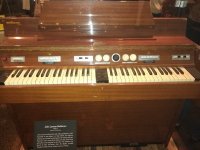 132938232_x.jpg732.3 KB · Views: 55
132938232_x.jpg732.3 KB · Views: 55 -
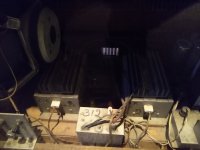 135038075_x.jpg429.2 KB · Views: 22
135038075_x.jpg429.2 KB · Views: 22 -
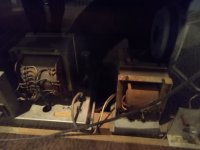 135019895_x.jpg414.2 KB · Views: 22
135019895_x.jpg414.2 KB · Views: 22 -
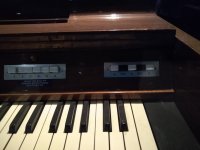 134956006_x.jpg415.3 KB · Views: 28
134956006_x.jpg415.3 KB · Views: 28 -
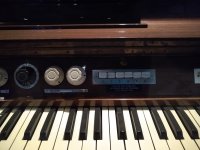 134952207_x.jpg481.9 KB · Views: 22
134952207_x.jpg481.9 KB · Views: 22 -
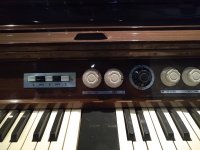 134945324_x.jpg515.9 KB · Views: 29
134945324_x.jpg515.9 KB · Views: 29 -
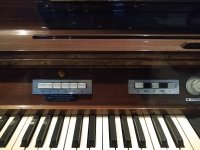 134935997_x.jpg526.5 KB · Views: 41
134935997_x.jpg526.5 KB · Views: 41 -
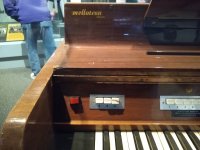 134928568_x.jpg554.4 KB · Views: 34
134928568_x.jpg554.4 KB · Views: 34 -
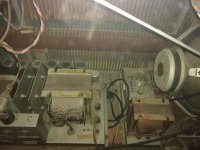 134846038_x.jpg669.9 KB · Views: 41
134846038_x.jpg669.9 KB · Views: 41 -
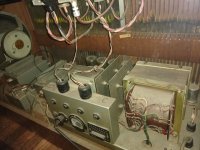 134830529_x.jpg760.1 KB · Views: 38
134830529_x.jpg760.1 KB · Views: 38
I have built some whacky stuff over the years......but I still have a couple of semi live cassette decks in my junk collection....but this stupid idea is far easier and might have a chance of success. I also went to a concert in about 1967 that killed my childhood fantasy of being a rock star.
I got to thinking about it a bit more, and if I was ever to really go pedal to the medal, I think I'd use a bunch of the old digital recording devices that Radio Shack put out 15-20 years ago or so. That would make things really simple. Heck, you could probably put one together and get something working in a few days
Either that, or I'd use some of those chips that Radio Shack put out that would allow you to play back a short, sampled waveform, if you can still find those for cheap. I'll search for them, as usual. I'm sure somebody bought a crap pile of those chips when they liquidated a few years back.
What would be really, really fun would be to connect the thing to one of those big-***, floor-based keyboards, where you have to step on the keys for them to play. You could install it in a mall or something other public venue
I'm thinking that some of the maker sites and the kids would love to see something like that, and we'd probably be Slash-dotted as well! LMAO!
If I only had the time!
The headliners were a crappy boy band called the Monkees. They had an annoying TV show that my mother liked.
I remember the show. Pretty much the American clone of The Beatles. I think VH1 or some other outfit did a documentary on them that I watched on YouTube.
She had even offered to pay for the tickets if my guitar playing friend would take me to their concert (his older brother could drive). My friend convinced me to accept the offer since the opening act was a unheard of new "awesome " guitar player. We went to the show, and were totally amazed at what we saw. The opening act....a newcomer named Jimi Hendrix.
He performed unique tricks of illusion and guitar magic that had me convinced that there were three of him…...I would later find out that there was three of him, one live, and two others that lived in little grey boxes on the floor. As the Mellotron and the Chamberlin before it were the grandfathers of today's sampling keyboards, the Echoplex in the 60's was the forerunner of today's guitar looper. And it worked pretty much the same way as the Mellotron, magnetic tape.
I'm completely and totally jelly
Never heard of the Echoplex, but I'll look it up for sure. I remember my cousin having a Moog synth, back in the day. I think he still has it, actually. Was never interested in it too much back then, as I was busy studying percussion, trumpet, trombone, and classical guitar at the time, trying to figure out which instrument interested me most. Guitar won
Unlike the Mellotron, the Echoplex was small, portable, and not ridiculously expensive. Like the Mellotron its tape transport mechanism led to constant maintenance, and eventual failure.....so after a couple years of searching, I managed to find a dead one in my price range, and make it work good enough for me to really annoy the neighbors.
Nice! Annoy the neighbors. I can relate to that
Another great thing about him was this: If you told him you were really interested in playing an instrument, he'd say, "Oh, really? Well, let's go get you one right now," and off to one of the local music shops we'd go. I think he paid something like 10% above cost or so, and he could return it for resale or something like that, although that never happened. They all gave him serious discounts because he taught percussion, jazz, and orchestra at the local university and high schools. He'd direct those kids in their direction if they were interested in buying an instrument, so it was in their interest to treat him well.
The Echoplex used a continuous tape loop. It had one erase head, one record head, one fixed playback head, and one movable head that could record or play. There were feedback controls to create many of those repetitive sounds that Jimi and others used. Jimi could slide that movable head on the fly with his foot, which is probably why the one I bought had a broken slide mechanism.
Maybe I try to make one, maybe I don't....I haven't decided yet, and I already have a looper pedal.
I hear ya, dude. I'm currently working on a project where I'm converting a CB radio to the ham bands, on and off, as health and time permits. I work on it about twice a month, but when I do, my eyesight starts to give and I have to put it away. Going to swap out the xtal-mixing scheme and install a DDS VFO for all-band coverage and such. When/if I finally get on the air with the thing, I'm probably going to get a bunch of flak and be called a CB operator and stuff. LOL. Hey, it's cheap, and it should work well
I wasn't that impressed. For us Cleveland is a 3 to 4 hour drive, and we had planned a few stops with a overnight stay in Amish country on the way home to pick up some hardwood.
I always wanted to stop off in Amish country and check things out. An old GF of mine went, and she said they served them breakfast that was out of this world. I told her, "Yeah. You were eating REAL food! Not this corporate BS that we have access to, woman!"
R&R HOF cost almost $50 each to get in, $40 for us old people. Once inside, some of the "experiences" cost extra. It was raining really bad, and we had to park a good distance away in the Cleveland Browns stadium parking lot and make a run for it. That's why my good camera stayed in the car. Phone pictures of the Mellotron are included.
$50.00!! Screw that noise! I can see $20.00 or so, but $50.00? Not happening. The phone pics were great, and thanks for uploading them, Tubelab.
Today it's easy and cheap to DIY a Mellotron. I built one for under $100 including keyboard, and it does work good. There is a big brother to the WAV Trigger called the Tsunami, It works even better since it can play something like 30 tracks at once.
YouTube (watch to the end)
WAV Trigger Downloads – robertsonics
I'll make sure I watch those before I hit the rack, Tube. Thanks!
73,
Randy AB5NI
Last edited:
The WAV Trigger and the Tsunami are great, and they'd sure save a lot time and a bit of cash doing something like this; however, they'd also take out all the fun of designing and building something like this as well -- for me, anyway. Personally, I love to reuse old electronics and see what I can come up with, Tubelab  .
.
I must say that I'm impressed with Trigger and Tsunami and the use of the SD card for WAV storage. OTOH, I'd also love to see a built-in FLAC codec as well. WAV just takes up too much space. Also, I'm not too sure I'd want an MP3 codec, as they mess around with the dynamic range too much for my taste. I'm pretty much a lossless compression aficionado. (Shrug.)
Hmmm. Maybe I could talk them into adding the FLAC codec into their board? I'd guess that they're using an FPGA instead of doing some ASIC chip, but I'm not sure what kinda room they have left on chip. Hopefully, they'd still have enough room to do something like this and come up with a B revision or something, but who knows? I'd imagine that they still have a LOT of room to spare. I was also thinking that waveform manipulation via fast fourier transformation would be interesting as well. Oh. I learned about this kinda stuff at "YouTube University" .
.
BTW, and just out of curiosity, what were you doing at Motorola all those years?
73,
Randy AB5NI
I must say that I'm impressed with Trigger and Tsunami and the use of the SD card for WAV storage. OTOH, I'd also love to see a built-in FLAC codec as well. WAV just takes up too much space. Also, I'm not too sure I'd want an MP3 codec, as they mess around with the dynamic range too much for my taste. I'm pretty much a lossless compression aficionado. (Shrug.)
Hmmm. Maybe I could talk them into adding the FLAC codec into their board? I'd guess that they're using an FPGA instead of doing some ASIC chip, but I'm not sure what kinda room they have left on chip. Hopefully, they'd still have enough room to do something like this and come up with a B revision or something, but who knows? I'd imagine that they still have a LOT of room to spare. I was also thinking that waveform manipulation via fast fourier transformation would be interesting as well. Oh. I learned about this kinda stuff at "YouTube University"
BTW, and just out of curiosity, what were you doing at Motorola all those years?
73,
Randy AB5NI
Last edited:
I'd guess that they're using an FPGA instead of doing some ASIC chip
Neither, The Wav trigger uses a microprocessor. Don't remember exactly what brand, but it is an ARM chip of some sort. My board is stuck inside a metal box for now, so I can't easily look at it.
I'm not too sure I'd want an MP3 codec
I wouldn't want one either since WAV's are uncompressed and storage is cheap today. You can get a 128GB micro SD card for $10. That will hold about 150 complete music CD's. I'm in the process of ripping my entire CD collection and some of my vinyl to the PC for instant recall playback. No more looking through over 600 CD's and 400 records. Today they will ALL fit on a 1 TB SSD that costs $89. Why bother with FLAC.
BTW, and just out of curiosity, what were you doing at Motorola all those years?
I started on the assembly line tuning and testing HT-220's in 1973( every old ham remembers those). After about a year and a half of that BS, I managed to get into the test equipment lab.
My primary duty there was to keep the factory's test equipment running on the evening shift. I made friends with all the other support techs, so that we covered each other's backs and kept things running. This left us with some free time, and we had half a million square feet of factory floor to play in, so we built stuff. Radio stuff, computer stuff, audio stuff, music making stuff.....
After about 8 years of that, we could see the factory winding down, and engineering taking over the building, so all of us started looking for engineering jobs. It's not easy convincing an engineering manager to hire you when you have no formal education in electronics, but I kept trying......After about 2 years, I got hired in development engineering because of a "Camaro" belt buckle! Then...poof I was an engineer.
I worked in several different product development groups for almost 20 years, moving every 3 to 5 years, mainly to learn something new, or do something different. I had a hand (or circuit design) in many of the 800 and 900 MHz trunking radios up to the Jedi program. As that was winding down, I transferred to a think tank group that was looking for new paging markets, two years later I was designing Nextel walkie talkie phones.
When the phone group started disintegrating I got into a research group that "defined the state of the art in two way radio communications." I stayed there for 12 years...until I got the "letter that you can not refuse" from the CEO.
It said, basically, leave now voluntarily and we'll give you a bucket full of money, or leave later and you'll get a boot print on your butt. I left in 2014.....the plant has been sold and about 2 or 3 hundred employees are left in a rented corner of a building that once employed 5000+.
Neither, The Wav trigger uses a microprocessor. Don't remember exactly what brand, but it is an ARM chip of some sort. My board is stuck inside a metal box for now, so I can't easily look at it.
Ah. ARM. Never really played around with ARM, although I do know they're used in a lot of cell phones and embedded systems. Guess I should spend a bit of time and look into them, and I also need to look into the SoC stuff as well. Wish I had the time! The last time I mucked around with SCADA and embedded control (at a professional level) was when the Motorola 68K-series, embedded-control microprocessors were popular
As far as embedded control goes, these days I've been playing around with the Arduino stuff. Really simple to use and implement in my RF designs for ham radio and such. I'll eventually use them in my audio gear as well, since I have a rekindled interest in the field.
I wouldn't want one either since WAV's are uncompressed and storage is cheap today. You can get a 128GB micro SD card for $10.
Damn! I didn't realize that stuff had become so cheap. I've been messing around with RF stuff a lot and not even paying attention to the latest, greatest aspects of the digital world. Well, I have been kind of paying attention reading slashdot and hackernews, but I was never really curious enough to scope things out in depth. These days, I'm more into going the opposite direction, designing and building stuff out of old, discarded electronics.
I have been considering getting more into the SMT stuff, but it's WAY too small for my eyes
That will hold about 150 complete music CD's. I'm in the process of ripping my entire CD collection and some of my vinyl to the PC for instant recall playback. No more looking through over 600 CD's and 400 records. Today they will ALL fit on a 1 TB SSD that costs $89. Why bother with FLAC.
I totally agree! Like I said above, I didn't realize that secondary storage had become so cheap. I'm with ya, bro!
I started on the assembly line tuning and testing HT-220's in 1973( every old ham remembers those). After about a year and a half of that BS, I managed to get into the test equipment lab.
I have 2-3 HT-220's hanging around in my junkbox myself
My primary duty there was to keep the factory's test equipment running on the evening shift. I made friends with all the other support techs, so that we covered each other's backs and kept things running. This left us with some free time, and we had half a million square feet of factory floor to play in, so we built stuff. Radio stuff, computer stuff, audio stuff, music making stuff.....
Man, that sounds like a job I would have really enjoyed myself
After about 8 years of that, we could see the factory winding down, and engineering taking over the building, so all of us started looking for engineering jobs. It's not easy convincing an engineering manager to hire you when you have no formal education in electronics, but I kept trying......After about 2 years, I got hired in development engineering because of a "Camaro" belt buckle! Then...poof I was an engineer.
Congrats, and MAJOR kudos on the really important thing in that sentence, which would be "Camaro."
I worked in several different product development groups for almost 20 years, moving every 3 to 5 years, mainly to learn something new, or do something different. I had a hand (or circuit design) in many of the 800 and 900 MHz trunking radios up to the Jedi program. As that was winding down, I transferred to a think tank group that was looking for new paging markets, two years later I was designing Nextel walkie talkie phones.
Mad respect designing VHF gear, dude! I've done a few designs at VHF (strip-line RF amps), and as we are both well aware, attaining stability at those frequencies can be somewhat allusive at times
I think I burned up like 3 or 4 GaSFET transistors before I finally got the final stable
When the phone group started disintegrating I got into a research group that "defined the state of the art in two way radio communications." I stayed there for 12 years...until I got the "letter that you can not refuse" from the CEO.
I always wanted to get into DMR work, but I was too busy doing contractual engineering for the oilfield service companies and most of the major oil companies as well. Ah, well. Maybe I'll get around to it in my next life or something
My last job was managing an engineering firm that specialized in logistics tracking for the oilfield. We did a lot of LAMP work and SCADA, and we also wrote something known as mud-logging and MWD (measurement while drilling) software as well. Fun days
It said, basically, leave now voluntarily and we'll give you a bucket full of money, or leave later and you'll get a boot print on your butt. I left in 2014.....the plant has been sold and about 2 or 3 hundred employees are left in a rented corner of a building that once employed 5000+.
Gone are the days when you could retire with a full pension, unfortunately, which is the reason I based my career around the smaller engineering firms that kicked butt and took names. I was really, really ticked off when Motorola was downsized so much. Let's call it what it is -- profit margins and the out-right greed of Wall Street!
UPS guy is here! Time to start melting solder! I'll let you guys know how things are working out later, for sure.
73,
Randy AB5NI
BTW, after seeing that Camaro buckle, I would have hired you too, dude
It was my spare parts collection for a 68 convertible that got me hired. The belt buckle is what told him to ask if I had a Camaro. Turned out that I had the same car he was restoring, and an extra set of the convertible only trim pieces that go around the convertible top opening in the rear. This was in 1984 before you could get repro parts.
profit margins and the out-right greed of Wall Street!
It was Wall Street, and one particular A$$ ho** that bought up enough stock to get his henchmen on the board of directors, then took over and broke up the company.....and sold off all the parts for the personal gain of himself and his loyal followers.
Today, only the two way radio division remains under the original Chicago company. All other use of the Motorola name is by license, or outright purchase of the division. My Motorola phone says "Motorola, a Lenovo company" on power up. Yes, this made money for the stockholders who had the guts to hold the stock for about 8 years of turmoil during all of the spin-offs and divestitures. During that time 120,000 employees lost their jobs, about 40,000 of them were in the USA. Somehow, this is called progress.
I've been playing around with the Arduino stuff. Really simple to use.....Never really played around with ARM
Take a look at these things. The 3.X and 4.0 versions are powered by Freescale (formerly Motorola, now owned by NXP) ARM chips, but they program using Arduino sketches. There is also a graphical environment for pasting together a bunch of different audio building blocks and turning it into code to be programmed into the parts. They are cheap yet really powerful, and overclockable.
I have built a full music synthesizer with a Teensy, an Audio Adapter, and a box full of pots. Their forum, like this one has zillions of DIY projects going on, including a RX only HF SDR. I will likely use one for demodulation when I get around to building an SDR project.
Products
It was my spare parts collection for a 68 convertible that got me hired. The belt buckle is what told him to ask if I had a Camaro. Turned out that I had the same car he was restoring, and an extra set of the convertible only trim pieces that go around the convertible top opening in the rear. This was in 1984 before you could get repro parts.
Nice. What a great stroke of luck! A good friend has a 68 hardtop SS. It's blue with the big white stripes. I think it's a 327, if I remember correctly.
I remember the days before CNC, 3D printing, and repro parts, for sure. We used to scour Hemmings Motor News for the parts we needed, back in the day. I love to watch Jay Leno's Garage, and I love it when he tells his tech to just print up or CNC some part or another. Then I remember all the BS we had to go through to find that stuff. If it was something rare, prepare to bend over and shell out some serious cash
A friend wrecked a 1960 327 Impala convertible. I was like, "You're screwed, dude!" He said, "Randy, shut the hell up and I know I am!"
Check this out. Back in the 70's, we used to scour the local junkyards for old muscle. A good friend of mine and I ran across a 1968 440 Charger for $500.00. We each coughed up $250.00, and we had the thing running the next day. Had something like 80K miles, but the motor was still very stout, and then some. We ripped up the roads for a couple of months and sold it for $1K. I was watching the Barrett-Jackson auction on TV a few years ago, and one just like it rolled off the block for $100K.
It gets worse. I was looking for some new muscle to fix and restore, and I came across a 426 Hemi Cuda covertible for $1.5K. I think it was a 68, if I remember correctly. I almost purchased the thing, but the rag-top was shot, and it had a bit of surface rust in the trunk. I think the rag-top was going for something like $400.00 or so new, and that was a good chunk of change in 1975 or so, so I balked and went on to find something else
I was watching that same Barrett-Jackson show, and one rolled off the block for 1.5M. Yes, I was utterly disgusted with myself that my foresight failed me! LOL! Wound up building sleeper Volkswagen Bugs and having fun with those
It was Wall Street, and one particular A$$ ho** that bought up enough stock to get his henchmen on the board of directors, then took over and broke up the company.....and sold off all the parts for the personal gain of himself and his loyal followers.
I remember seeing a documentary on the collapse of Motorola. I know the A-hole you're talking about. Also watched a documentary on the collapse of Zenith. Both were quite tragic. I'm pretty sure you can locate them on YouTube, BTW.
Today, only the two way radio division remains under the original Chicago company. All other use of the Motorola name is by license, or outright purchase of the division. My Motorola phone says "Motorola, a Lenovo company" on power up. Yes, this made money for the stockholders who had the guts to hold the stock for about 8 years of turmoil during all of the spin-offs and divestitures. During that time 120,000 employees lost their jobs, about 40,000 of them were in the USA. Somehow, this is called progress.
I remember when it happened, and I was cursing up a storm and saying to myself that it was complete and utter BS. After I watched the documentary, I was even more ticked off. One thing I absolutely adored about Motorola: you guys built brick-crap-house gear that could really take some abuse -- and then some! The HT-220 was a great example of this, too.
Take a look at these things. The 3.X and 4.0 versions are powered by Freescale (formerly Motorola, now owned by NXP) ARM chips, but they program using Arduino sketches. There is also a graphical environment for pasting together a bunch of different audio building blocks and turning it into code to be programmed into the parts. They are cheap yet really powerful, and overclockable.
Nice. I'll give them a look, for sure.
I have built a full music synthesizer with a Teensy, an Audio Adapter, and a box full of pots. Their forum, like this one has zillions of DIY projects going on, including a RX only HF SDR. I will likely use one for demodulation when I get around to building an SDR project.
Products
A couple of my buddies over at YouTube University and The University of Walmart -- LOL! -- are messing around with the Teensy and SDR. Check out charlie's design(s):
YouTube
Better yet, just search Teensy SDR and you'll get a plethora of info one the subject, and I'll make sure and check out the links you've provided as well. Thanks!
73,
Randy AB5NI
JMFahey said:
Quote:
To connect a Guitar (High Z) to a grid input? (again High Z)
NO
Your bad indeed because you try to interconnect 2 Hi Z devices using a 600:600 ohm transformer.AB5NI said:
Wow. Maybe all those years of study of applied physics was just a waste of my time and money. My bad. It seems to me that although they are both high Z components, some form of calculation would be appropriate for maximum power transfer. Overkill? Probably, but that's me. Worth it in a one-off design. Probably. Again, my bad!
Here, from your own drawing:
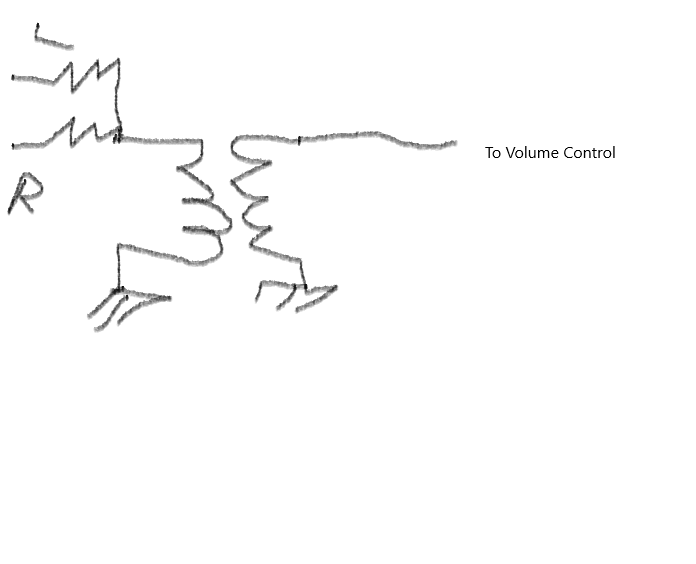
...... I could use an old 600-600 transformer out of an old transistor AM radio to solve the issue, .......
....... I'm wondering if the 600-600 transformer is going to be the correct input impedance for the tube ......
I thought you were starting to get it when you wrote:
my brain tells me, "No! This has to be calculated for the correct impedance for maximum-power transfer!
but then you fell again in your own trap:believing you can use input transformers in a 1M class circuit:
Just for kicks , on a slow/boring day grab those Amidon spec sheets and calculate/design a suitable transformer, working at that very high impedance level.I have a TON of Amidon cores hanging around, so winding my own transformer shouldn't be that big of a deal, I'm guessing.
I bet you will be surprised
As in: a zillion turns of atoms thick wire (unwindable, of course).
And don´t make me start on winding capacitance, loss inductance and very probable resonance peak well within the Audio band.
But not everything is that bleak, you simply do NOT need such a transformer, can connect guitar straight to input grid if you wish, NO 100´s of Volts there.
Take care.
Your bad indeed because you try to interconnect 2 Hi Z devices using a 600:600 ohm transformer.
Here, from your own drawing:
WHY do you think I'm here asking to begin with? I thought it was strange connecting two devices in this manor using a 600-to-600 transformer. It would give me isolation, sure, but 600-to-600 ohms? That was just too weird, and I knew something must be amiss.
I notice you didn't even mention the grid-to-plate short. Didn't think about that, now did you? THAT will be dangerous voltage on the grid, for sure, which is why I said right after that, that I forgot the DC-blocking cap.
but then you fell again in your own trap:believing you can use input transformers in a 1M class circuit:
Just for kicks , on a slow/boring day grab those Amidon spec sheets and calculate/design a suitable transformer, working at that very high impedance level. I bet you will be surprised
Now, wouldn't it have been nice if somebody would have just came out and said that to begin with, which, yet again, is the reason I'm here. I've said that I'm a noob/neophyte in many areas of design -- I admit that, and then some.
But then I run across somebody like you, as I always do in the technical world. What you're trying to do is pontificate and make yourself look good at my expense, belittling me along the way. You're not in this thread to teach. You're here to look like a technical guru or something and talk down to the uninitiated laymen. Sorry, but homey don't play those games.
Do me a small favor and actually apply your analytical-only brain to the analysis of social interaction. One thinks you would have caught on to this by now, but evidently not.
And don´t make me start on winding capacitance, loss inductance and very probable resonance peak well within the Audio band.
Why not? Maybe we can talk about cross-winding capacitance and circulating currents due to heating in inductors as as well? Not with you -- that's for sure!
But not everything is that bleak, you simply do NOT need such a transformer, can connect guitar straight to input grid if you wish, NO 100´s of Volts there.
Take care.
I tell you what. Let's do this: let's put an old, used 12AX7 tube in the preamp where the instrument/device connects. Also, let's put some crappy caps in that preamp circuit as well, with a lot of leakage. Let's also use some old, out-of-tolerance resistors for bias as well. Let's monitor the voltages on the grid and plate. Let's monitor this tube until failure. Let's do this on a number of nearly-shot tubes and see how many of them go plate-to-grid short.
Admittedly, that will probably be on the low side, statistically speaking, but it can and will eventually happen to someone. THAT is the reason I want grid isolation in my designs. THAT is the reason I am here.
Good gear can be used for a long time, as in many, many years. We're dealing with tubes here, where heat can be an issue, causing indirect heating of components and causing them to fall out of tolerance. The situation I described can and will happen, eventually, so I'm going to make sure that I do through and complete analysis of the situation and I'm prepared for such an eventuality.
I want you to do me another favor. On a slow, boring day, I want you to think about the person(s) in these forums that you actually respect the utmost. I want you to take note of their overall disposition and social interaction with the group. You can bank on it that it's going to be someone who is well liked socially.
Alright, I'm growing tired of all this passive-aggressive BS. Please leave me alone. Go away. That is, unless you decide to actually add something to the conversation in a non-lecturing fashion and are actually interested in teaching and helping. I'm willing to let bygones be bygones. Let's move on, bro.
Last edited:
Well, it looks like the only thing I can come up with is using some form of optical isolation on the input port. Being a audio-design noob, I'm not sure if I can expect the thing to have enough dynamic range and not bandwidth restrict the input. I'm guessing that it should work, or am I spinning my wheels here, folks? (Shrug.)
73,
Randy AB5NI
73,
Randy AB5NI
Last edited:
If you use one of the N-68X isolation transformers on the line cord input, then there is no need for any isolation on the guitar input, just connect the guitar ground to circuit ground and the guitar hot to the grid of the audio driver tube through a DC blocking cap of about 0.022 uF. The cap may not be required if the tube is cathode biased.
Here is the schematic of a guitar amp I made for about $50 using hot chassis radio tubes. The X2 terminals connect to the N-68X secondary, and X3 connect to the OPT, a $5 line matching transformer from Parts Express.
The input pentode stage is there for super overdriven (Jimi) sounds, and is not really needed. The phase inverter is a mosfet, but another tube could be used. This uses 100 mA series heater tubes from the last generation of tube radios before the transistor killed them all. 50C5's, 12AV6's, and 12AU6's could be used, or even 50L6's, 12SQ7's and 12SJ7's.
Plate to grid shorts are rare unless the tube has been physically abused. They are even rarer in small signal tubes....So maybe a 1 in a zillion short happens....you gave a cap in series with the input, so nothing other that the tube gets hurt. I have been abusing tubes in DIY guitar amps since the 1960's and I've never seen a plate to grid short in an input tube.
Here is the schematic of a guitar amp I made for about $50 using hot chassis radio tubes. The X2 terminals connect to the N-68X secondary, and X3 connect to the OPT, a $5 line matching transformer from Parts Express.
The input pentode stage is there for super overdriven (Jimi) sounds, and is not really needed. The phase inverter is a mosfet, but another tube could be used. This uses 100 mA series heater tubes from the last generation of tube radios before the transistor killed them all. 50C5's, 12AV6's, and 12AU6's could be used, or even 50L6's, 12SQ7's and 12SJ7's.
how many of them go plate-to-grid short.
Plate to grid shorts are rare unless the tube has been physically abused. They are even rarer in small signal tubes....So maybe a 1 in a zillion short happens....you gave a cap in series with the input, so nothing other that the tube gets hurt. I have been abusing tubes in DIY guitar amps since the 1960's and I've never seen a plate to grid short in an input tube.
Attachments
Last edited:
- Status
- This old topic is closed. If you want to reopen this topic, contact a moderator using the "Report Post" button.
- Home
- Amplifiers
- Tubes / Valves
- Guitar Amp, Phono Amp, Blue Tooth AM Radio